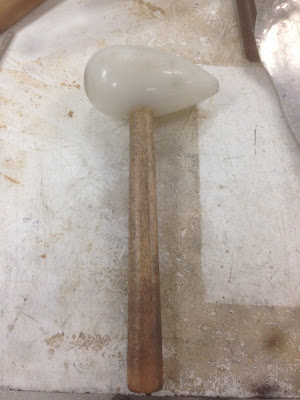- In regards to choosing an object for fabrication, it is most favourable to select an item which is not too complicated, and does not have a multitude of curves.
- Unfortunately my object, the human hand, was an object that is quite hard to replicate due to the numerous crevasses, movements and directions which the 'shape' has.
- During the photogrammetry phase using AutoDesk's 123D Catch, it is highly beneficial to be thorough and attentive in scanning and modelling of the chosen shape; reducing the possibility of mistakes and need to re-scan later on.
- The object should be scanned in an environment with generous amounts of sunlight, allowing the photos taken using the app to be clear and unobstructed.
- Additionally, a large range of photographs upon the object's X, Y and Z axis should be taken, providing a 360 degree view around the shape but also in its height and verticality. There should not be a limited placed on the required number of photographs, as the more taken the more detail can be implemented into the modelling of the object.
- If there is a need to remodel or repair the scanned object, AutoDesk's Meshmixer should be used to smooth out any inconsistencies and patch up any 'holes' picked up during the scan. In particular the 'Flatten' and 'ShrinkSmooth' functions are the most useful to create a neat and even shape.
- During the construction phase of the template, thought should be placed into the material in which the template is to be made.
- The method of construction method should be firstly trialed in AutoDesk's 123D Make, as it will provide an estimation to the structural possibility of each shape using different methods. This also displays an estimation to the amount of materials necessary, and this is a useful feature as it can eliminate wastage and ultimately provide the most (cost and time) efficient method.
- An object that is modeled using the 'interlocking' or 'radial' method should avoid softer materials such as Boxboard, White Card or Balsa wood, due to its softer density.
- Materials such as plywood or acrylic as they would be recommended, as they are highly sturdy and provide a degree of structure to the shape.
- Furthermore, the construction method of the shape should reflect the shape of the template, whereby an object which is directed horizontally would utilise the 'vertical stacking' method.
- The process of shaping such a delicate and complex object was quite difficult, due to the multiplex of contours and movements.
- It is essential to use a type of aluminum metal sheet that is the correct thickness, which would allow for easier malleability and movability. As learnt from my own experience of metal shaping with both thin and thick aluminum, the thicker sheet (although is more susceptible to harder hitting) is much more difficult to shape.
- The necessity to properly mark out the areas which need to be 'shaped' should not be ignored, because during the metal shaping process, the movement of the metal can result in confusion and 'loss of bearings' within the sheet.
- During any process of shaping the metal, whether it is shrinking, stretching or bending, it is highly recommended to stop approximately 5 - 10 millimetres before the line in order to account for movements when proceeded to the next task.
- A general rule of thumb during this process was to avoid 'stretching' the metal sheet more than is necessary, as it is almost impossible to shrink an overstretched area.
- A great degree of care should be used when using the 'shrinker stretcher', where due to its many 'teeth' it can easily imprint 'teeth marks', scratches and even tears in the skin of the metal sheet.
Shrinker Stretcher
Shrinker stretcher must be used in moderation
Overuse can create bends
Tears from overuse
- Although polishing can be used during finalisation of the shape, it is not entirely sucessful in removing scartches and stretch marks produced by the shinker stretcher. As a result, it may be considered to avoid this machine completely and use the more traditional method tree stump stretching.
Partially polished shape, with highly visible stretch marks
- Consideration should be placed upon choice of tools, as each tool although can provide similar effects is also different in its strength and hardness. Nylon mallets are able to produce a strong and defined 'indent' into the metal sheet (at times leaving marks when used against an anvil or sandbag), whereas wood mallets provide a more gentle and less intrusive method of metal shaping when used with anvils and timber blocks.
Nylon Mallet
Wooden Mallet
- Finally, there are a wide variety of anvils and tools available within the Squarehouse workshop, and these can be used to achieve a multitude of curves, contours and shapes. Although these may appear similar, it is important to select the correct anvil (in terms of size), as it will determine the degree of stretch in which is imparted into the shape. Once a stretch has been created on a metal sheet, it is much more difficult (and should be avoided when possible) to shrink.
Different sized mushroom steel dome dollies








No comments:
Post a Comment